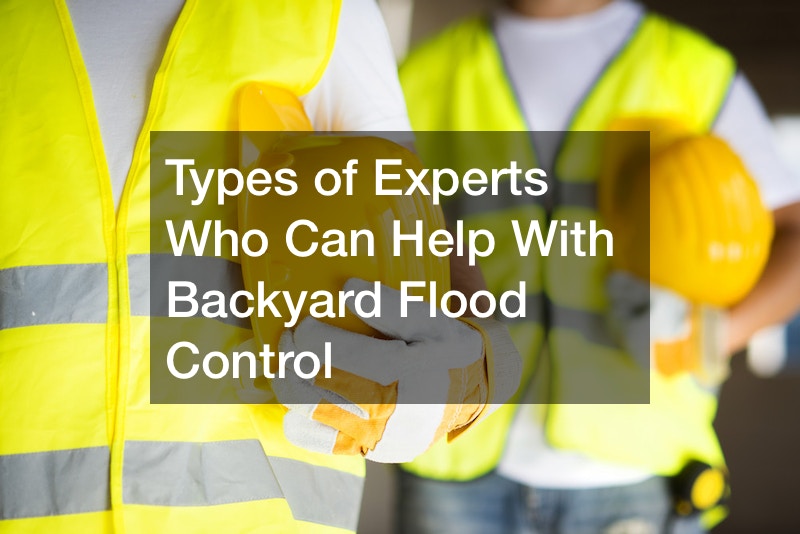If you’re facing the frustrating and potentially dangerous issue of backyard flooding, there are experts who specialize in backyard flood control. These professionals possess the knowledge and skills to assess the causes of flooding. They can also design an effective drainage system and implement preventive measures to protect your property. With their expertise in backyard flood control, they can help you reduce water accumulation and prevent erosion. Consider these experts the next time you find that you have more water than grass in your backyard.
Getting Your Yard Dry

When your yard falls victim to a flood, the aftermath can be devastating. However, with the right approach and assistance, you can restore your yard to what it once was. When you want your yard dry after a flood, you should start with lawn drainage companies. Lawn drainage companies specialize in assessing, designing, and implementing drainage systems. They also have the expertise and equipment necessary to manage excess water to prevent flooding. Lawn drainage companies start by evaluating the current drainage situation in a yard. During this evaluation, they assess the slope, soil, and composition. In addition, they learn the water flow patterns and any existing drainage systems.
During the analysis, they identify the underlying causes of poor drainage and determine the most suitable solutions for backyard flood control. With the assessment, lawn drainage experts create customized drainage plans. Factors like the size of the yard, local regulations, and the specific drainage needs of the property are considered. The design often includes the installation of drainage channels, pipes, catch basins, or other drainage structures. They will dig trenches, lay pipes, and position drainage structures in the appropriate locations. This ensures efficient water flow and prevents future water accumulation in the yard. Lawn drainage companies often use French drains to redirect water away from yards. These drains consist of perforated pipes buried in gravel-filled trenches. The pipes collect and redirect excess water, preventing it from pooling in the yard.
Drain field restoration is the process of repairing, rejuvenating, or replacing a drain field. A drain field is a critical part of a septic system. A drain field is often called a leach field or absorption field. It’s a subsurface area where the treated wastewater from a septic tank is distributed and naturally filtered back into the soil. Drain fields can experience issues that interfere with their functionality. These issues include clogging, compaction, or saturation. Drain field restoration works to address these problems and restore the drain field’s proper functioning. A professional septic system specialist assesses the condition of the drain field, checks for signs of clogging or saturation, and determines the cause of the problem. When a drain field is experiencing blockages or clogging, jetting may be performed to remove obstructions. High-pressure water is used to clear the pipes and distribution lines. This process allows the wastewater to flow more freely into the surrounding soil.
Identify the Real Cause of Flooding

When you find yourself dealing with flooding in your backyard, it’s important to understand the cause of the issue. When you understand the underlying factors contributing to flooding, it is essential for effective resolution, prevention, and backyard flood control. To determine the root cause of the flooding, you must conduct a thorough investigation. The best place to start is by assessing the extent and nature of the flooding. Look for visible signs such as water accumulation, water stains on walls or floors, or damage to structures or belongings. Take note of the affected areas and the patterns of water flow. If the flooding has caused significant property damage or personal injury, it may be beneficial to consult a personal injury attorney. These professionals can help assess the situation from a legal perspective. They can also help determine liability and guide you through the process of seeking compensation if necessary.
Evaluate the weather conditions that occur before and after the flooding. Heavy rainfall or storms are common causes of backyard flooding. When you check local weather reports or consult experts, you can gather accurate information about the rain levels and any unusual weather patterns. Inspect the drainage systems in your backyard, including gutters, downspouts, and underground drainage pipes. During the inspection, check for any clogs, blockages, or damage that may prevent the proper flow of water. Inadequate or malfunctioning drainage systems can contribute to water accumulation and subsequent flooding. You should assess the landscaping in your yard. Improper grading, where the ground slopes towards your property instead of away from it, can lead to water pooling and flooding. Observe any landscaping features that may prevent the natural flow of water, such as retaining walls or poorly positioned plants.
Foundation problems like leaks or cracks are often caused by flooding. Inspect your home’s foundation for any signs of damage, such as water seepage or structural issues. Foundation problems allow water to enter your home, resulting in indoor flooding. There are some instances when flooding is related to municipal systems. You should determine if there are any issues with the local stormwater management infrastructure, sewer lines, or other public systems. Through the process of the investigation, document any evidence related to the flooding. While documenting, be sure to take photographs of the affected areas and collect records or documentation. You should keep a record of conversations with experts or authorities.
Keeping Your Yard Dry

When you are looking for ways to have backyard flood control, you want to work hard to keep it dry and free from excess water. Drilling companies play a critical role in keeping your yard dry with specialized techniques and equipment to manage groundwater levels and prevent water accumulation. Some of the techniques drilling companies may use include well installation. Dewatering wells or sump pumps are among the items they may install. These wells collect and remove excess groundwater from your yard, lowering the water table and preventing water from seeping into the soil. Dewatering systems may also be installed. This includes installing perforated pipes or well points in strategic locations. These systems create a network of drainage points to collect groundwater and pump it out of the yard, keeping the soil dry.
Deep well injection involves drilling deep boreholes and injecting excess water back into deep aquifers. This removes the water from the surface and prevents yard flooding. When you’re thinking about backyard flood control, you may want to use a water treatment system. Water treatment systems can help manage excess and persistent water issues. These types of systems can include rain barrels, rain gardens, or retention ponds that collect and treat rainwater. Water treatment systems not only help prevent flooding but also promote sustainable water management. Landscaping plays a vital role in backyard flood control. Consider incorporating features such as swales, berms, or permeable surfaces to redirect and absorb excess water. Planting trees and shrubs strategically can also help soak up water and stabilize the soil.
Plumbing services can help keep your yard dry by addressing and resolving water-related issues. While plumbing typically addresses internal water supply and drainage systems, it can indirectly affect the condition of the yard. Plumbing services identify and repair any leaks within your plumbing system. This could include leaky pipes, faucets, or fixtures. Water leaks cause excess water accumulation in your yard, causing soggy areas or even flooding. When plumbers fix leaks quickly, it can stop water from flowing into the yard. This helps the yard stay dry. Slow drainage can be caused by a blockage, which also causes backups in the plumbing. When the water doesn’t flow through pipes, it can cause an overflow of water into the yard.
Dealing With the Structural Damages

If you want to take a critical step in backyard flood control, you should consider dealing with the structural damage of your home. A flood can cause significant damage to the structural integrity of your property. This includes the foundations, walls, and other elements. Residential foundation repair and restoration services are ideal ways to repair structural damage. Flooding often causes soil erosion and saturation around your property’s foundation. When this occurs, it can compromise the stability and strength of the foundation. This makes your home vulnerable to further damage.
Structural damage caused by flooding includes cracks in walls or foundations, creating pathways for water to seep into your property. Addressing these damages through restoration services seals off these entry points. Taking this action prevents water from seeping into your home and causing further flooding. Structural damages impact the functionality of your drainage systems, which makes flooding issues worse in your backyard. As part of the restoration process, experts can assess and optimize your existing drainage systems. During their assessment, they will ensure proper water flow and efficient drainage away from your property. This helps prevent water accumulation and reduces the risk of future flooding. It’s common for floodwaters to wash away or shift the grading of your yard. When this happens, it has a negative impact on the natural flow of water.
It’s important that you contact a professional to handle any structural damage or grading issues. This will ensure that water is directed away from your property during heavy rainfall. Additionally, they can suggest appropriate landscaping modifications to aid in backyard flood control. This can include the strategic placement of plants, trees, or retaining walls. Restoration services for damaged structural elements provide the capability for the structure to hold up against future flood events. Reparation services may include repairing damaged walls, reinforcing beams, and replacing compromised materials to restore the structural strength of your property. Floodwater creates the perfect environment for mold and mildew to grow on your property’s structure. Timely restoration and repair of structural damages help reduce the risk of mold. This is critical for maintaining a dry yard and providing a safe and healthy living environment.
Getting Rid of Environmental Changes

When you need effective backyard flood control, addressing environmental changes is crucial. Environmental changes, such as the presence of pests like flies, can contribute to water accumulation. To reduce these issues, it is essential to take steps to target those environmental factors. Pest infestations make any water in your backyard worse. Flies are attracted to moisture and breed in areas with stagnant water. When you contact a professional pest management service company, they can help control fly populations and reduce their presence in your yard. When you remove or reduce the presence of flies, you reduce the factors that contribute to water contamination and potential flooding.
Flies thrive in spaces where there is organic matter and standing water. Take steps to remove potential breeding grounds from your yard. To do this, take steps to clean up pet waste promptly, cover trash cans tightly, and remove any standing water in containers or puddles. These actions disrupt the fly life cycle and reduce the likelihood of fly infestations, contributing to better backyard flood control. Overgrown vegetation can prevent water flow and drainage. Regularly trim trees, shrubs, and other plants in your yard to prevent them from obstructing natural water pathways. When you have well-maintained vegetation, it promotes better water absorption and reduces the risk of water pooling in your backyard.
Strategic landscaping helps backyard flood control. Consider grading your yard to ensure proper water runoff away from your property. Create swales or berms to divert water flow or install rain gardens that absorb excess water. These landscaping techniques help manage water effectively and prevent flooding in your yard. Surfaces like concrete or asphalt are impermeable, which means water won’t go through it. These surfaces contribute to water runoff and increase the risk of backyard flooding. When you add pavers or gravel to your yard, it helps reduce the water that collects and stands in the yard. Rainwater harvesting systems control water accumulation while providing an alternative water source for non-potable uses. These systems collect rainwater from your roof and direct it to storage tanks or rain barrels. By capturing and utilizing rainwater, you reduce the amount of water that contributes to backyard flooding.
By incorporating pest management services, implementing proper landscaping techniques, and addressing other environmental changes, you can have effective backyard flood control. Taking these steps will help make your yard more flood-resistant and give you an enjoyable outdoor space.




